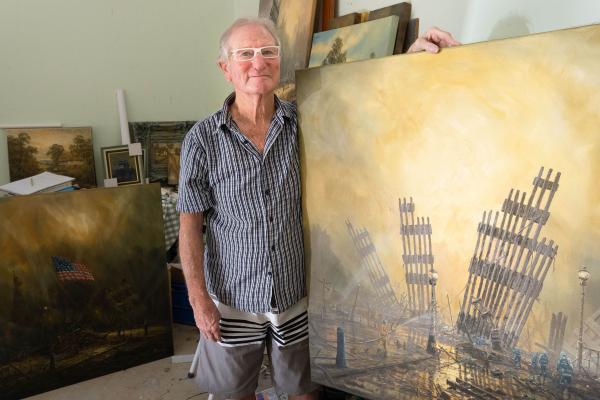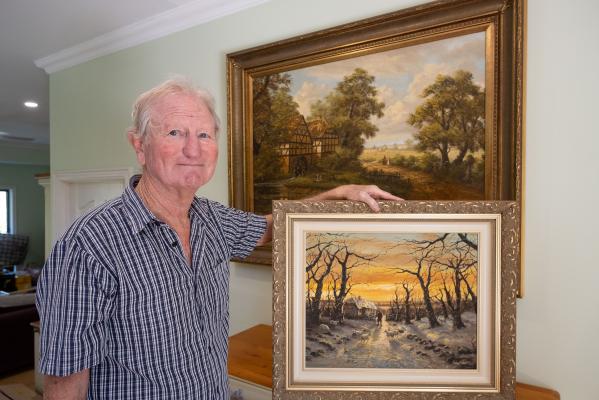He’s an artist of international reputation and a retired pug, who on retirement, was still good enough to earn a dollar working as a sparring partner for visiting European and world champions. And this is a compliment in itself. On Tuesday and Thursday evenings, at approximately 5pm, this elderly English gentleman, a landscape artist of renown, will walk quietly through the doors of Israel Kani’s NBO Boxing and Fitness Gymnasium in Project Avenue Noosaville. On entering, he will walk through the gym, past the rings where young hopefuls are sparring, and proceed to drop his kit in the corner. While doing so, he will greet fellow gym mates with a smile and a nod of the head.
After gearing up for his training session, and a bit of shadow boxing to warm up, he will then proceed to work-out on a big heavy bag for three or four rounds. Following this, he will sometimes hop up onto the apron of the ring, and, leaning over the top rope between rounds, quietly offer some advice to a young fighter.
“I love training there: Israel runs the NBO in a real professional manner and the young people are great.”
For 80-year-old Robert Ixer, retired former welterweight amateur and professional boxer, this is nothing out of the ordinary.
“I have been training constantly now for some 55 years and still enjoy doing so. I also do two nights a week at Frankie’s gym in Noosa. If I hadn’t kept myself fit,” he adds with a laugh, and pointing to floor, “I would probably now be down-under.”
This remark came about as a result of, some eight years ago, having survived open heart surgery. But now, fully recovered and back in the gym he is again full on.
Born in London in 1941, and having studied at South- East Essex Technical College and School of Arts and St Martins School of Arts, he left school at age 15 with a definite feeling for what he wanted to achieve in life. On moving into the world of commercial art he would spend the next six years at various London advertising agencies.
“After dropping out of this line of work, I realised that I had not been very happy: to me, it was just too commercial.”
While at art school, his interest saw his attention drawn to the highly successful paintings of John Constable, the artist known principally for his ability to revolutionise the genre of landscaping painting.
“I was familiar with some of his areas and became greatly inspired by his work, inspired to such a degree that when working on an art piece, it would make me feel that I was back in that era.”
Not only his work as a landscape artist, but also his paintings of seascapes and the ocean, show a deep feeling for the subject matter: a feeling for the sea.
This has resulted in some of his best works, incredible paintings of ocean and shoreline scenes, as well as ships at sea.
“My feeling for the ocean came about as a result of my many hours spent around various beaches.”
After rejecting the commercial world, he became a pavement artist, working with chalk, outside London’s National Gallery Trafalgar Square.
“When it wasn’t raining this was a great experience, but when it rained it would wash it all away and that would be the end of that,” he said with a smile and a shake of his head.
It was during this time that he entered the world of boxing hoping it would add a few more dollars to his income.
“I had joined a gym at 21 but did not start boxing till I was 25. I boxed as a welterweight and fought in both the amateur and professional ranks for a total of 30 fights for 24 wins, winning a few district championships.” Perhaps his best performance, was two fights against the reigning British champion for one loss and a win. Apart from his boxing, he also played professional soccer and won some district titles in swimming. But the sporting achievement of which he is most proud was his involvement in training British welterweight Tony Sibson for a world title fight against the legendary Marvellous, Marvin Hagler.
‘’Despite losing, the Americans rated it one of Hagler’s toughest fights. This was great effort against one of the greatest of all time: something I am very proud of.’’
In 1961 Robert, living in an outer suburb of London, married a young lady named Pat, who lived just around the corner.
Then in 1964, Robert felt a desire to travel, so with his wife Pat and first- born son Warren in tow, travelled to Canada. Their stay in Canada was short, and they soon returned to Cornwall in England.
Then after some years in Cornwell he had his first exhibition and this greatly encompassed the English countryside. In doing so Robert created a style of centuries past and this was well accepted.
“This was a great start. The chap who ran the gallery also gave me good advice on how to market my work for sale.”
Before leaving England, which he would eventually do for his family’s sake, (a family of three sons and a daughter), he lived 10 years in Lincolnshire. As a result, the local landscape became the subject for many of his paintings.
It was during this time that his reputation as a landscape artist had him looked upon as one of England’s finest and this was to result in many TV and press features, but above all, his work was now being exhibited in Selfridges and Harrods, major department stores in London with their own galleries.
Also, at this time a peculiarity was being noticed in his work. He had started to incorporate a small bucket somewhere in every painting, and now some art collectors would hesitate to buy his work unless it contained the genuine Ixer bucket.
The eventual move for his family’s sake, came about when, in 1984 at age 43, he shifted to New Zealand and settled on the Kapiti Coast, at the foot of the Tararua mountains, mountains which were to feature in some of his art work.
With his family settled he once again began to paint- New Zealand landscapes and ocean scenes in the old English style. The exhibitions of his work were very successful, good reviews and gallery sales.
For the next 14 years they remained in New Zealand, but then decided to move on. This time it was to the Gold Coast for a holiday and then a look around.
“We travelled to Noosa, fell in love with the place and at age 58 and Pat, 57, we built a home. Why Doonan you ask? It’s beautiful and quiet, we could not ask for better.”
However, an incident occurred that they found upsetting. Following 9/11, Robert had decided to do paintings based on the tragedy.
One was the absolute carnage with firemen prominent in the subject. The other was similar, but as a tribute to the courage, pride and the spirit of the American people, through the dust and smoke he placed the American flag and in the background, just visible is the Statue of Liberty.
‘’You won’t believe it, but because it was a tragedy and people were killed, I got a lot of hate mail accusing me of doing it just to make money from this tragedy. If I am able to sell these paintings, we are going to donate a large amount of the money to our local fire brigade.
“Also, like it or not, it is a part of the nation’s history, and by putting it on canvas, it will enable us to show our young ones, down through the years, what their country and people have suffered.”
The art critic’s statement that Roberts “ability to adapt to any preference,’’ is indeed what’s makes his work acceptable to such a wide audience. Other paintings, with subject matter revolving around military, ocean battles and animals (horses and dogs, with some painted on black velvet) bears witness to this statement. Despite a career that from the 1970s til the 1990s, had our local citizen Robert “Bucket Bob” Ixer rated by international critics,and admired by British Royalty, as one of the finest landscape artists in the world, his greatest pride and joy is his family: wife Pat, daughter Sally and sons Warren, Lee and Russell.
“This year we celebrate 59 years of happily married life. When we celebrate, I will be looking forward to sitting back and listen to my son Russell, now 56, singing Nessun Dorma and reaching all the high notes. I couldn’t be prouder or happier.”
Well done, Robert Ixer, well done.








